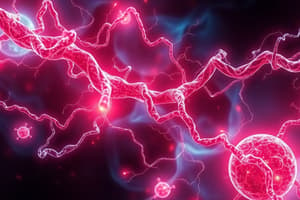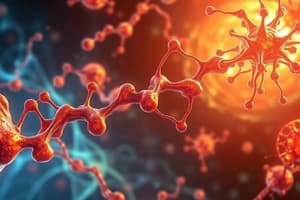Podcast
Questions and Answers
What do anabolic pathways do?
What do anabolic pathways do?
- Consume energy to form complicated molecules from simpler ones (correct)
- Are a type of endocytosis
- Release energy by breaking down complex molecules
- Absorb free energy
What is activation energy?
What is activation energy?
The investment of energy required to start a reaction.
What do catabolic pathways do?
What do catabolic pathways do?
- Occur during photosynthesis
- Absorb free energy
- Require energy to form molecules
- Release energy by breaking down complex molecules (correct)
What characterizes an endergonic reaction?
What characterizes an endergonic reaction?
What is an exergonic reaction?
What is an exergonic reaction?
What does induced fit refer to?
What does induced fit refer to?
What is a desmosome?
What is a desmosome?
What is a hypertonic solution?
What is a hypertonic solution?
What happens to an animal cell in a hypertonic solution?
What happens to an animal cell in a hypertonic solution?
What happens to a plant cell in a hypertonic solution?
What happens to a plant cell in a hypertonic solution?
What are competitive inhibitors?
What are competitive inhibitors?
What is the function of the cytoskeleton?
What is the function of the cytoskeleton?
What do non-competitive inhibitors do?
What do non-competitive inhibitors do?
What is the extracellular matrix?
What is the extracellular matrix?
What are glycoproteins?
What are glycoproteins?
What does the Second Law of Thermodynamics state?
What does the Second Law of Thermodynamics state?
What are glycolipids?
What are glycolipids?
What is simple diffusion?
What is simple diffusion?
What is facilitated diffusion?
What is facilitated diffusion?
What is the role of enzymes?
What is the role of enzymes?
What is cholesterol's function in the membrane?
What is cholesterol's function in the membrane?
What is active transport?
What is active transport?
What does it mean when an enzyme is denatured?
What does it mean when an enzyme is denatured?
What is the First Law of Thermodynamics?
What is the First Law of Thermodynamics?
What do mitochondria produce?
What do mitochondria produce?
What is phagocytosis?
What is phagocytosis?
What is the main function of the endoplasmic reticulum (E.R.)?
What is the main function of the endoplasmic reticulum (E.R.)?
What is the function of the Golgi body?
What is the function of the Golgi body?
What is the central vacuole's purpose?
What is the central vacuole's purpose?
What are vesicles?
What are vesicles?
What is endocytosis?
What is endocytosis?
What are the differences between prokaryotic and eukaryotic cells?
What are the differences between prokaryotic and eukaryotic cells?
What are lysosomes?
What are lysosomes?
What is the phospholipid bilayer?
What is the phospholipid bilayer?
What are peripheral proteins?
What are peripheral proteins?
What are integral proteins?
What are integral proteins?
What is the function of ribosomes?
What is the function of ribosomes?
What is the plasma membrane?
What is the plasma membrane?
Flashcards are hidden until you start studying
Study Notes
Metabolism and Energy
- Anabolic pathways consume energy to synthesize complex molecules from simpler ones.
- Catabolic pathways release energy by degrading complex molecules into simpler forms.
- Activation energy is the initial energy investment required to begin a chemical reaction.
- Endergonic reactions absorb free energy, exemplified by photosynthesis.
- Exergonic reactions release energy, with respiration being a prime example.
Enzyme Function and Inhibition
- Induced fit refers to the alteration of the enzyme's active site to more effectively bind the substrate.
- Competitive inhibitors resemble the substrate and compete for the active site, which can be outmatched by increasing substrate concentration.
- Non-competitive inhibitors change the enzyme's shape, affecting its activity.
Cell Structures and Functions
- Desmosomes are intercellular junctions in animal cells providing anchorage.
- The cytoskeleton is found inside cells and is essential for transport and maintaining cell shape.
- The extracellular matrix exists outside the cell, providing structural support.
- Glycoproteins and glycolipids play key roles in cell recognition through covalent bonding with carbohydrates.
Osmosis and Diffusion
- Hypertonic solutions have a higher solute concentration than the cell, causing water loss.
- In a hypertonic solution, animal cells shrivel, and plant cells undergo plasmolysis, causing wilting.
- Simple diffusion involves solutes moving across a membrane down their concentration gradient without energy.
- Facilitated diffusion allows polar molecules to pass through transport proteins without energy.
Membrane Structure
- The phospholipid bilayer consists of hydrophilic heads and hydrophobic tails, making it selectively permeable.
- Integral proteins span the membrane for transport and recognition, while peripheral proteins are loosely bound to the membrane surface.
Cellular Transport Mechanisms
- Active transport moves molecules against their concentration gradient, requiring energy and proteins.
- Endocytosis encompasses the uptake of macromolecules through the plasma membrane forming vesicles.
- Phagocytosis is a type of endocytosis involving the engulfing of larger substances.
Thermodynamics and Cellular Function
- The first law of thermodynamics states that energy cannot be created or destroyed, only transformed.
- The second law indicates that energy transformations increase entropy, or disorder, in the universe.
Organelles and Their Functions
- Mitochondria are the powerhouse of the cell, responsible for ATP production.
- Lysosomes contain hydrolytic enzymes for digestion within animal cells.
- The endoplasmic reticulum (E.R.) transports and directs proteins while the Golgi body modifies and packages them.
- Central vacuoles serve as storage sites within plant cells.
- Ribosomes are the site of protein synthesis within the cell.
Cell Types
- Eukaryotic cells are characterized by membrane-bound organelles and are generally larger than prokaryotic cells.
Studying That Suits You
Use AI to generate personalized quizzes and flashcards to suit your learning preferences.




